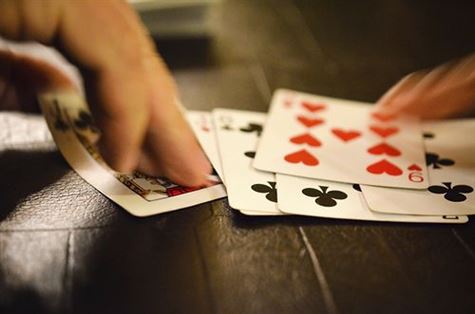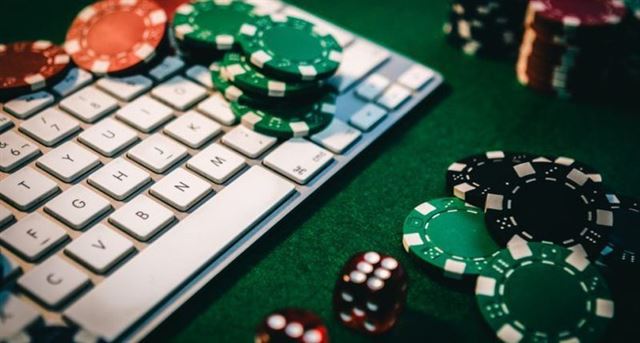Poker is a game of skill, strategy, and calculated risks. While luck plays a role in short-term outcomes, long-term success in poker heavily relies on understanding and utilizing mathematical concepts. From calculating probabilities to making optimal decisions based on expected value, the mathematics behind winning poker is a crucial aspect that separates the amateurs from the professionals. In this article, we will delve into the key mathematical principles that underpin successful poker play, providing insights into how numbers can be crunched to gain an edge at the poker table.
The Role of Probability in Poker: Understanding the Mathematics Behind Winning Hands
At its core, poker is a game of making decisions based on incomplete information. Players are dealt a certain number of cards, and they must use their knowledge of the game and their opponents to make the best possible decisions. This is where probability comes into play.
Probability is the branch of mathematics that deals with the likelihood of events occurring. In poker, probability is used to calculate the odds of certain hands being dealt, the likelihood of certain cards being drawn, and the chances of winning a hand based on the cards in hand and the cards on the table.
One of the most basic concepts in poker probability is the calculation of outs. Outs are the cards that can improve a player’s hand. For example, if a player has four cards to a flush, there are nine remaining cards of that suit in the deck. Therefore, the player has nine outs to complete their flush. By calculating the number of outs, players can determine the probability of improving their hand and make informed decisions about whether to bet, call, or fold.
Another important concept in poker probability is pot odds. Pot odds are the ratio of the current size of the pot to the cost of a contemplated call. By comparing the pot odds to the odds of completing a hand, players can determine whether it is mathematically profitable to make a call. If the pot odds are higher than the odds of completing the hand, it is a profitable call in the long run.
Understanding the concept of expected value is also crucial in poker. Expected value is the average amount a player can expect to win or lose on a particular bet over the long run. By calculating the expected value of a bet, players can determine whether it is a profitable move. If the expected value is positive, it means that the bet is likely to result in a net gain over time.
In addition to these basic concepts, there are more advanced mathematical strategies that can be used in poker. These include calculating the probability of specific hands being dealt, using game theory to make optimal decisions, and analyzing opponents’ betting patterns to gain an edge.
Statistical Analysis in Poker: How Data and Numbers Can Improve Your Game
One of the key aspects of statistical analysis in poker is understanding probabilities. Every decision a player makes is based on the likelihood of certain outcomes. For example, when deciding whether to call a bet, a player must consider the probability of their hand improving and the potential payoff if it does. By calculating these probabilities, players can make more accurate decisions and avoid costly mistakes.
Another important aspect of statistical analysis in poker is tracking and analyzing data. Many players use software programs to record and analyze their hand histories. These programs provide valuable insights into a player’s performance, such as their win rate, average pot size, and the types of hands they tend to play. By analyzing this data, players can identify patterns and trends in their play and make adjustments accordingly.
One common statistical tool used in poker is the concept of expected value (EV). EV is a measure of the average amount of money a player can expect to win or lose on a particular decision. By calculating the EV of different actions, players can determine the most profitable course of action. For example, if the EV of calling a bet is positive, it is a profitable decision in the long run.
In addition to EV, players also use other statistical concepts such as standard deviation and variance to assess risk. These concepts help players understand the potential swings in their bankroll and make decisions that balance risk and reward. By understanding the statistical distribution of outcomes, players can make more informed decisions and manage their bankroll more effectively.
Statistical analysis also plays a crucial role in hand range analysis. Hand range analysis involves estimating the range of hands an opponent is likely to have based on their actions and the information available. By assigning probabilities to different hands in an opponent’s range, players can make more accurate decisions and exploit their opponents’ weaknesses. This analysis requires a deep understanding of probability theory and statistical concepts.
Furthermore, statistical analysis can also be used to identify and exploit patterns in opponents’ play. By analyzing large datasets of hand histories, players can identify tendencies and patterns in their opponents’ play. For example, if a player consistently raises with a certain hand, it can be exploited by adjusting one’s own strategy accordingly. This type of analysis requires a combination of statistical skills and a keen eye for patterns.
Game Theory and Poker: Applying Mathematical Strategies for Optimal Decision Making
Game theory, a branch of mathematics, is the study of strategic decision making in situations where the outcome of one’s choices depends on the choices of others. In poker, players must make decisions based on incomplete information, as they cannot see their opponents’ cards. This is where game theory comes into play, as it provides a framework for analyzing and making decisions in such situations.
One of the fundamental concepts in game theory is the concept of expected value (EV). EV is a mathematical calculation that represents the average outcome of a decision over the long run. In poker, players can use EV to determine whether a particular decision is likely to be profitable or not. By calculating the EV of different actions, players can make informed decisions that maximize their potential winnings.
To calculate the EV of a decision in poker, players must consider two factors: the probability of each possible outcome and the payoff associated with each outcome. For example, if a player is considering whether to call a bet, they must calculate the probability of winning the hand and the amount they stand to win if they do win. By multiplying the probability of winning by the potential payoff and subtracting the probability of losing multiplied by the potential loss, players can determine the EV of calling.
Another important mathematical concept in poker is pot odds. Pot odds refer to the ratio of the current size of the pot to the cost of a contemplated call. By comparing the pot odds to the odds of completing a particular hand, players can determine whether it is mathematically correct to call a bet. If the pot odds are higher than the odds of completing the hand, it is a profitable decision in the long run.
In addition to EV and pot odds, players can also use mathematical concepts such as expected frequency and variance to inform their decision making. Expected frequency refers to the average number of times a particular event is expected to occur over a given period. By considering the expected frequency of certain outcomes, players can adjust their strategies accordingly.
Variance, on the other hand, measures the degree of uncertainty or risk associated with a particular decision. In poker, players must be aware of the variance associated with different actions and adjust their strategies accordingly. For example, a player may choose to play more conservatively if they are in a high-variance situation, where the potential losses are greater.
Calculating Expected Value in Poker: Maximizing Profits through Mathematical Analysis
Expected value is a mathematical concept that represents the average outcome of a given situation over the long run. In poker, it is used to determine the profitability of a particular play or decision. By calculating the expected value of a play, players can assess whether it is likely to be profitable or not.
To calculate the expected value of a play, players must consider two factors: the probability of each possible outcome and the payoff associated with each outcome. For example, let’s say a player is considering whether to call a bet on the river with a flush draw. The player must first determine the probability of completing the flush on the next card. If the player believes there is a 25% chance of completing the flush, they can assign a value of 0.25 to that outcome.
Next, the player must consider the payoff associated with completing the flush. If the pot is $100 and the player expects to win $200 if they complete the flush, they can assign a value of $200 to that outcome. Conversely, if the player expects to lose $100 if they miss the flush, they can assign a value of -$100 to that outcome.
Once the player has assigned probabilities and payoffs to each possible outcome, they can calculate the expected value by multiplying the probability of each outcome by its associated payoff and summing the results. In the example above, the expected value of calling the bet with a flush draw would be calculated as follows:
(0.25 * $200) + (0.75 * -$100) = $50 – $75 = -$25
A negative expected value indicates that the play is likely to be unprofitable in the long run. In this case, the player would be better off folding their hand and avoiding the potential loss.
On the other hand, a positive expected value indicates that the play is likely to be profitable in the long run. For example, if the expected value of calling a bet with a flush draw was calculated to be $50, the player would expect to make $50 on average every time they made that play. Over a large number of repetitions, this would result in a significant profit.
By calculating the expected value of different plays and decisions, players can make more informed choices at the poker table. They can identify plays that are likely to be profitable and avoid those that are likely to result in losses. This mathematical analysis allows players to maximize their profits and make the most of their poker skills.
The Mathematics of Bluffing in Poker: Using Probability to Fool Your Opponents
Bluffing is a technique used by players to deceive their opponents into thinking they have a stronger hand than they actually do. It is a risky move that requires careful calculation and an understanding of probability. By understanding the mathematics behind bluffing, players can increase their chances of successfully fooling their opponents.
To bluff effectively, players must consider the probability of their opponents having a better hand. This involves calculating the number of possible hands that could beat their own. For example, if a player has a pair of kings, they must consider how many possible hands their opponents could have that would beat them, such as a pair of aces or a straight. By understanding the probability of these hands, players can determine the likelihood of their bluff being successful.
Calculating the probability of opponents having certain hands involves understanding the concept of outs. Outs are the cards that can improve a player’s hand and potentially give them the winning hand. For example, if a player has four cards to a flush, there are nine remaining cards of that suit in the deck. This means they have nine outs to complete their flush. By knowing the number of outs, players can calculate the probability of completing their hand and determine if bluffing is a viable option.
Another important mathematical concept in bluffing is pot odds. Pot odds refer to the ratio of the current size of the pot to the cost of a contemplated call. By comparing the pot odds to the odds of completing their hand, players can determine if it is mathematically profitable to make a bluff. If the pot odds are higher than the odds of completing their hand, it may be a good time to bluff.
In addition to calculating probabilities and pot odds, players must also consider their opponents’ tendencies and playing styles. Understanding the mathematics behind bluffing is only one piece of the puzzle. Players must also be able to read their opponents and make educated guesses about their likely actions. By observing their opponents’ betting patterns and previous actions, players can make more accurate assessments of their opponents’ hands and increase the effectiveness of their bluffs.
Bluffing in poker is a delicate balance between mathematics and psychology. While understanding the probabilities and pot odds is crucial, players must also be able to effectively deceive their opponents and manipulate their perceptions. Bluffing is a high-risk, high-reward strategy that requires careful calculation and a deep understanding of the game.
In conclusion, the mathematics of bluffing in poker is a complex and fascinating aspect of the game. By understanding the probabilities, pot odds, and outs, players can make more informed decisions and increase their chances of successfully fooling their opponents. However, it is important to remember that bluffing is not a guaranteed strategy and should be used sparingly and strategically. Ultimately, the key to successful bluffing lies in finding the right balance between mathematics and psychology.




